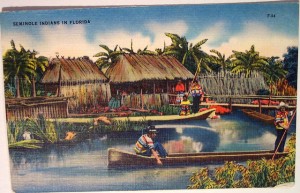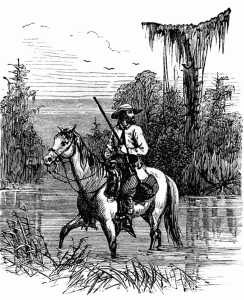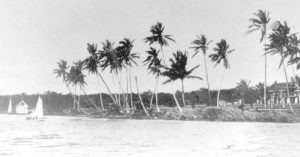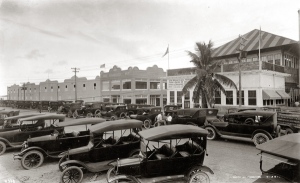History of American Crime: Gangsters on the Gold Coast, Part I
Gangsters on the Gold Coast: Setting the Stage
 Visitors to Florida’s southern Atlantic coast understand why it is also known as the Gold Coast. Some of the nation’s most exclusive real estate lies on a narrow strip of land roughly between Hobe Sound and the US 1 bridge connecting the mainland to Key Largo. For well over a century the Gold Coast has been the playground of the rich, famous, and infamous. Early November marks the annual migration of the snowbirds, the seasonal residents and visitors escaping colder climes. This influx, simply known as The Season, lasts until April when the snowbirds return north. The Miami area is arguably the beating heart of the Gold Coast, but its glitz and glamor are relatively recent developments.
Visitors to Florida’s southern Atlantic coast understand why it is also known as the Gold Coast. Some of the nation’s most exclusive real estate lies on a narrow strip of land roughly between Hobe Sound and the US 1 bridge connecting the mainland to Key Largo. For well over a century the Gold Coast has been the playground of the rich, famous, and infamous. Early November marks the annual migration of the snowbirds, the seasonal residents and visitors escaping colder climes. This influx, simply known as The Season, lasts until April when the snowbirds return north. The Miami area is arguably the beating heart of the Gold Coast, but its glitz and glamor are relatively recent developments.
Florida has always been different from the other Atlantic Seaboard states. Spanish rather than English was its first European language. Its swamps and forests offered refuge to native peoples hiding from said Europeans. When Anglo settlers started moving into Spanish northern La Florida during the 18th century, they were not the cultured sons of the wealthy. Those folks were as fiercely independent and stubborn as their Celtic ancestors. After control of the territory bounced back and forth between Spain and Britain, Spain finally gave up and sold Florida to the United States by the 1821 Adams-Onis Treaty.
 Prior to the purchase, General Andrew Jackson had already tangled with the Seminoles because they harbored runaway slaves and crossed the international boundary to raid south Georgia’s farms and settlements. Once president, he began the removal of the southeast’s native peoples in earnest, but he found the Seminoles more difficult to subdue and dispossess than their indigenous neighbors in Georgia, Alabama, Tennessee, and the Carolinas. Perhaps it was because the Seminole tribe was actually made up of a smattering of Florida’s original inhabitants accustomed to the harsh climate, outcasts from other tribes needing refuge, and slaves seeking freedom.
Prior to the purchase, General Andrew Jackson had already tangled with the Seminoles because they harbored runaway slaves and crossed the international boundary to raid south Georgia’s farms and settlements. Once president, he began the removal of the southeast’s native peoples in earnest, but he found the Seminoles more difficult to subdue and dispossess than their indigenous neighbors in Georgia, Alabama, Tennessee, and the Carolinas. Perhaps it was because the Seminole tribe was actually made up of a smattering of Florida’s original inhabitants accustomed to the harsh climate, outcasts from other tribes needing refuge, and slaves seeking freedom.

A Cracker from the Glades
Statehood in 1845 brought an even greater influx of Anglo settlers, giving rise to Florida’s Cracker Culture. Florida Crackers lived hard, often isolated lives. They grew their own food and fiber, wove fabric and sewed their own clothes, and made their own liquor all without interference from governments. Survival in Florida took independence, grit, determination, and a strong constitution regardless of one’s origins. The inhospitable environs at the tip of the peninsula might have remained the province of Native Americans and Cracker settlers but for a visionary woman, Julia Tuttle, who first saw southern Florida in 1875 when she visited her father’s homestead.
 After being widowed, she purchased 640 acres on the north bank of the Miami River in 1886 and her promotion of the area began. It was she who dreamed of a great city on the banks of the Miami River and she who convinced industrialist Henry Flagler to extend his Florida East Coast Railroad to the Miami area. It was she who realized Miami’s potential as a commercial hub for trade with Central and South America. Her focus was on a bright and prosperous future, but one that did not include the sale and consumption of alcoholic beverages. She and Flagler were both strong temperance-minded folks. From the very first, they worked to keep Miami free of alcohol and vice.
After being widowed, she purchased 640 acres on the north bank of the Miami River in 1886 and her promotion of the area began. It was she who dreamed of a great city on the banks of the Miami River and she who convinced industrialist Henry Flagler to extend his Florida East Coast Railroad to the Miami area. It was she who realized Miami’s potential as a commercial hub for trade with Central and South America. Her focus was on a bright and prosperous future, but one that did not include the sale and consumption of alcoholic beverages. She and Flagler were both strong temperance-minded folks. From the very first, they worked to keep Miami free of alcohol and vice.

View of the north bank of the Miami River where Julia Tuttle once owned 640 acres
What they did not envision was that rapid growth, the injustices of segregation and bigotry, economic boom and bust, and base human nature would play so big a roll in Miami’s development. Lawlessness, including gambling, prostitution, drugs, and murder were all part of life in south Florida. Oddly, Tuttle and Flagler had no objection to gambling. Though gambling was outlawed by the state, casinos flourished in Flagler owned hotels and games of chance were played in Tuttle’s home. Perhaps their own flaunting of the law established a pattern, for despite attempts at keeping her dry and free from vice, Miami was a wide open city from the very start. Not all of her citizens were happy with that state of affairs, however. Temperance sentiment grew until in 1913, desires for an alcohol free environment were realized in a local option election. Miami and Dade County were now dry, but the simple act of passing a law in no way guaranteed compliance. The effect of outlawing alcohol was simply to increase business for already established illegal operations, turning moonshining and bootlegging into growth industries.

Smith’s Casino, Miami beach, 1920’s
By the time the 1920 Volstead Act dried up all legal sources of alcohol in the nation, certain segments of Miami’s population were long accustomed to ignoring the law and the rest of the populous seemed disinclined to bring them to heel. Of course, a corrupt constabulary did nothing to promote adherence. Layer upon these circumstances and attitudes the birth of the tourist industry and the first Florida land boom, and Miami was now ripe for a more coordinated effort at quenching the public’s thirst and satisfying its basest desires.
Historical Fiction Set in South Florida
Nonfiction of Interest
Additional Reading
Beardsley, Ruth Robbins. Pioneering in the Everglades. Clewiston: Clewiston Museum, 1973.
Chepesiuk, Ron. Gangsters of Miami. Fort Lee, NJ: Barricade Books, 2010.
Denham, James M. and Brown, Canter, Jr. Cracker Times and Pioneer Lives: the Florida Reminiscences of George Keen and Sarah Pamela Williams. Columbia: University of South Carolina Press, 2000.
Gaines, Steven. Fool’s Paradise: Players, Poseurs, and the Culture of Excess in South Beach. New York: Three Rivers Press, 2009.
Ste. Claire, Dana. Cracker: the Cracker Culture in Florida History. Gainesville: University of Florida Press, 1998.
Linda Bennett Pennell is an author of historical fiction set in the American South or about Southerners traveling far from home. While she writes about the land of her birth, anything with a history, whether shabby or regal, ancient or closer to our own day, has fascinated her since early childhood. This love of the past and the desire to create stories of it probably owes much to her Southern roots.
Southern families are filled with storytellers who keep family and community histories alive. It is in their blood and part of their birthright. Linda’s family had many such yarn spinners who entertained the family on cold winter evenings around her grandmother’s fireplace and during long summer afternoons on her wraparound porch. And most important of all, most of those stories were true.
Click here to connect with Linda and find out more about her writing.







This was really interesting, thanks for sharing! Also, thank you for the book recommendations, I’ll be sure to check those out! 🙂
LikeLiked by 2 people
Thank you for dropping by and commenting, Emma! Glad you enjoyed the post!
LikeLiked by 1 person
Another informative AND interesting post, Linda! You always have so much intriguing information when you blog. It was a wonderful way to begin my day 🙂
LikeLiked by 1 person
Thank you, Lo! We endeavor to please, entertain, and inform!
LikeLike
Oh this is fascinating!
LikeLiked by 1 person
Thank you so much, Jennifer!
LikeLike
Wonderful post, Linda. All I know about Florida is the time I spent in northern Fla, never on the coast. It’s enlightening to hear about how it originally developed.
LikeLiked by 1 person
Thank you,Becky! What part of north Florida?
LikeLike
A great read as usual.
LikeLiked by 1 person
Thank you, Wareeze!
LikeLike
As always, Linda, love your historical perspective on things. Didn’t know that a woman was the one who envisioned Miami. Knew about Flagler, and his railroad. Two of my very favorite vacations were spent in Saint Augustine and Key West. I have a book set in Key West with TWRP. Key West’s history is fascinating, too.
Interesting about the gambling versus the temperance movement. Love these details!
LikeLiked by 1 person
Thank you, Hebby! Key West and St. Augustine are two of the most interesting places in Florida – unique, imbued with history, and funky in their own wonderful ways.
LikeLike
Fascinating post, Linda. My uncle has lived in Florida for decades and has tried to get us to move out there. He’s always talking about the “snowbirds,” too. Thanks for sharing.
LikeLike
Thank you Mary! What part of Florida? There are many beautiful places to live there!
LikeLike
May I ask a question? Do you have any idea as to how employers asked their servants to serve food in the late 19th century? Can’t find that answer anywhere. Thanks, Gail
*Gail * *203-372-3777*
Gail Ingis, ASID Curator of Art Lockwood-Mathews Mansion Museum
[image: logo]
INDIGO SKY | “A Triumphant Tale of Courage.” Get this one!” 5-Star Gail Ingis, Author and Visual Artist http://www.gaiingis.com | gailingisclaus@gmail.com
Website | Artist Page | Amazon | Facebook | Goodreads | Twitter | Trailer | B&N
On Fri, Jul 6, 2018 at 3:03 AM, History Imagined wrote:
> Linda Bennett Pennell posted: ” Gangsters on the > Gold Coast: Setting the Stage Visitors to Florida’s southern Atlantic coast > understand why it is also known as the Gold Coast. Some of the nation’s > most exclusive real estate lies on a narrow strip of land rough” >
LikeLike
Hi Gail! I think there are several considerations that must be taken into account before an answer can be found. Location (e.g., US? UK? European country? City? Rural? State? Region?), social strata (e.g., Royalty? Aristocrat? Middle class? Working class with one servant?), time setting (e.g., early, middle, or late 19th?) all play a part in answering your question. If you are interested in socially prominent, wealthy, upper class New Yorkers in the late 19th century, you cannot go wrong by using Edith Wharton’s work as your guide. Both The House of Mirth and The Age of Innocence give terrific insight into northern upper class Gilded Age mores and customs. If your story is set in the UK, I recommend my blog partner, Caroline Warfield’s well researched work. Sorry to be so vague, but I think you will find what you are looking for once you narrow your search.
LikeLike